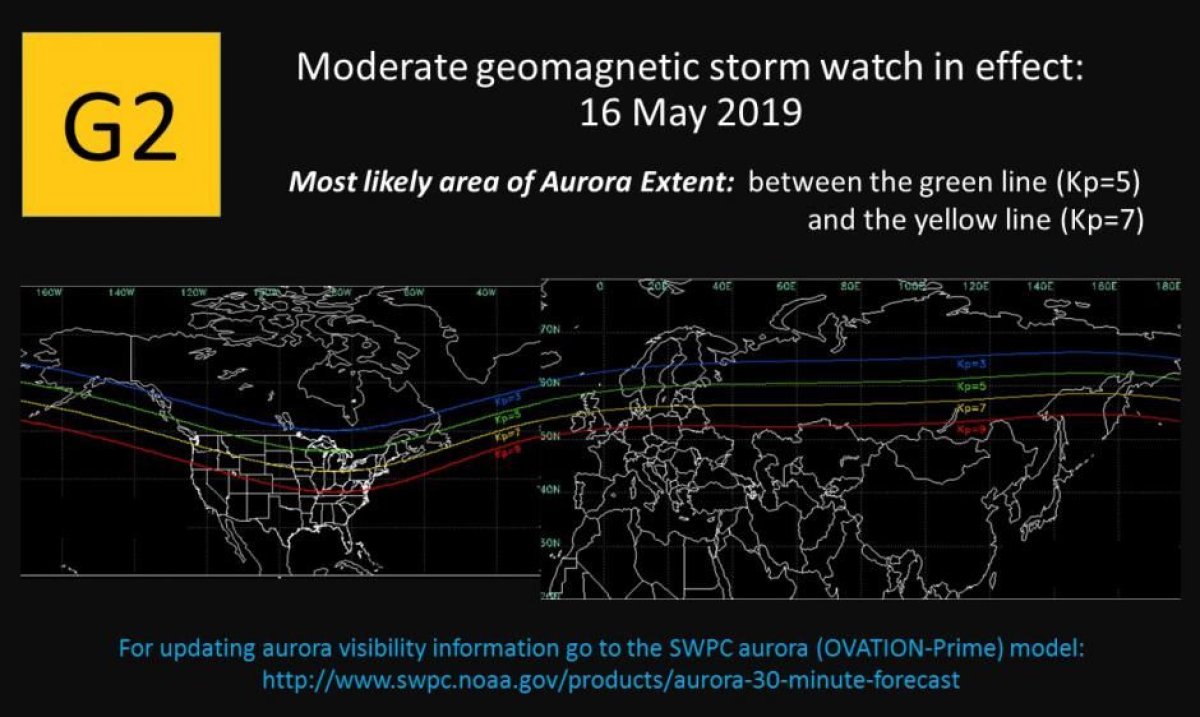
A geomagnetic storm making its way to Earth may mean auroras will be visible over parts of the U.S. on May 16. The storm is the result of a series of coronal mass ejections (CMEs) from the sun, the National Oceanic and Atmospheric Administration's (NOAA) Space Weather Prediction Center said.
Initially, the NOAA categorized it as a "minor" geomagnetic storm—this is still in effect between May 15 and 17. However, the agency has now issued an update to say a "moderate geomagnetic storm watch" will be in effect on May 16.
CMEs are explosions in the corona—the outermost part of the sun's atmosphere. Extremely strong magnetic fields are in this region. When these fields become confined and stressed, they need to be reconfigured, resulting in a sudden release of electromagnetic energy—a CME—ejecting coronal material outward. If the CME is directed toward Earth, the particles interact with our atmosphere, producing auroras.
Starting on May 10, the sun produced three CMEs from a sunspot group called Region 2741. These are now on their way to Earth, and when they hit, will produce auroras.
"The geomagnetic field is likely to reach G1 (Minor) storm levels, with a chance for G2 (Moderate) levels on day one (15 May) in reaction to CME effects," a NOAA statement said. "Day two (16 May) is likely to respond with storm levels up to G2, with a chance for G3 (Strong) due to expected reactions from another CME. Day three (17 may) is likely to experience up to G1 storm levels, with continuing chance for G2 conditions in response to yet another CME."
According to the Space Weather Prediction Center, auroras may be visible over northern parts of the U.S., with the area of impact "primarily poleward of 55 degrees Geomagnetic Latitude.… Aurora may be seen as low as New York to Wisconsin to Washington state."
A map showing the predicted storm can be seen below. The aurora is likely to extend between the green and yellow lines. States potentially affected are Washington, Idaho, Montana, North and South Dakota, Minnesota, Wisconsin, Michigan, New York, Vermont, New Hampshire and Maine.

For those hoping to view the aurora, the NOAA offers a guide on where people can check geomagnetic activity and the latitude of their location.
The latest geomagnetic storm is fairly small. When the biggest CMEs are produced, the resulting solar storm can have major impacts on Earth, disrupting satellite systems and GPS and knocking out electrical grids. The biggest solar storm ever recorded took place in 1859 and is known as the Carrington Event.
Uncommon Knowledge
Newsweek is committed to challenging conventional wisdom and finding connections in the search for common ground.
Newsweek is committed to challenging conventional wisdom and finding connections in the search for common ground.
About the writer
Hannah Osborne is Nesweek's Science Editor, based in London, UK. Hannah joined Newsweek in 2017 from IBTimes UK. She is ... Read more
To read how Newsweek uses AI as a newsroom tool, Click here.








